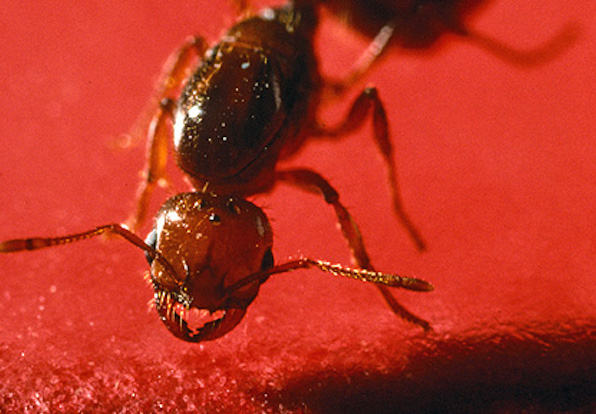By Andrew Casas
USDA ARS Office of Communications
Part Two of a Series
Scientists hope research onto a water-resistant delivery method will soon be useful in creating more methods of controlling fireants.
The red imported fire ant, Solenopsis invicta, threatens public health, agricultural productivity, and biodiversity. Bait and mound treatment with synthetic insecticides are major tools for controlling fire ants.
Fire ant baits are usually formulated as granules containing three major components: a slow-acting insecticide, vegetable oil as a food source, and a carrier. Unfortunately, all fire ant bait products in the current market have two big issues: 1) they attract a wide range of native ants since many native ants are also attracted to vegetable oil (ants that are vital to our ecosystems), and 2) they are easily dissolved and degraded when they get wet, so they can’t be used when rain is expected or in environments with high moisture.
Fire ants are social insects, meaning they live together in organized colonies in which they work cooperatively and efficiently. As social insects, ants communicate through pheromones, which are chemical signals they use for different purposes, such as marking their territory, signaling danger to their colony or alerting others about food sources nearby.
Jian Chen, a research entomologist with ARS’s Biological Control of Pests Research Unit in Stoneville, MS, studies the chemistry of fire ants, including understanding fire ant pheromones and their utilization in managing fire ants.
Recently, Dr. Chen found that fire ants feed their own venom to their nest mates when he found venom in their digestive systems. Fire ants use venom alkaloids as internal antibiotics, which keeps them healthy because their venom can suppress the growth of various pathogens. Interestingly, he also discovered that incorporating venom alkaloids into vegetable oil does not affect the feeding of fire ants, but it could shut down the feeding of native ants that compete with fire ants for the bait.
Adding fire ant venom alkaloids in vegetable oil can enhance the specificity of current bait products. ARS has filed a patent application for this unique approach to solve fire ant bait specificity issue.
“Collective utilization of venom as an internal antibiotic must play an important role in the social life of fire ants and their evolution,” said Chen. “This discovery will not only help us better understand fire ant social immunity, but also have a great impact on efforts to develop baits and microbial insecticides for managing fire ants”.
In addition to the improvement of bait specificity, Dr. Chen’s group has been working on creating a bait that is more water resistant than current commercial products.
“In commercial fire ant products, corn grit is generally used as a carrier,” said Chen. “Since corn grit easily disintegrates when in contact with water, current bait products can only be used when the ground and grass are dry, and rain is not expected. We have developed water-resistant fire ant baits by either modifying or replacing corn grits.”
For home mound treatment, Chen noted that homeowners have an ever-increasing interest in less toxic products for fire ant control, and chemicals from natural products are believed to be more desirable than conventional synthetic insecticides. Collaborating with his scientific partners, Chen’s group is screening several naturally occurring compounds for new and safer alternatives.







